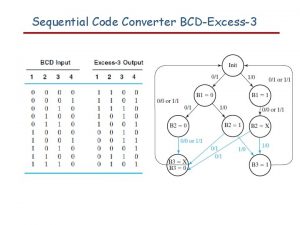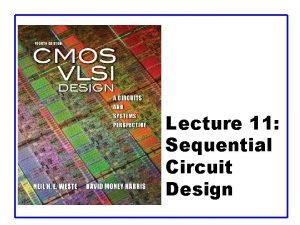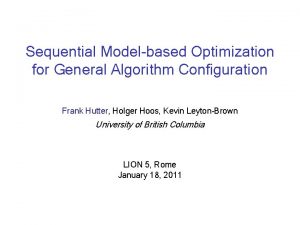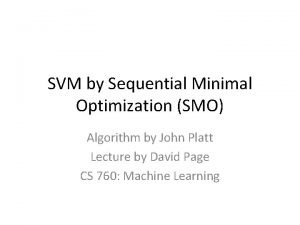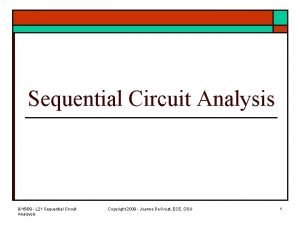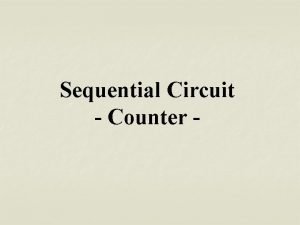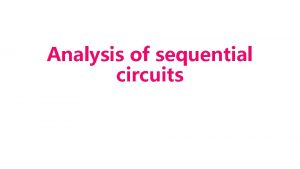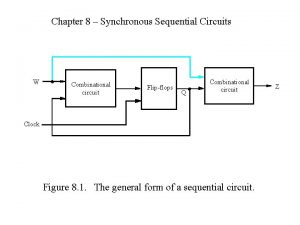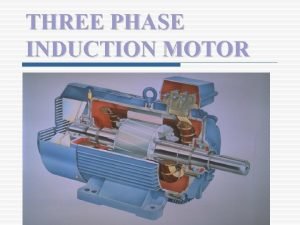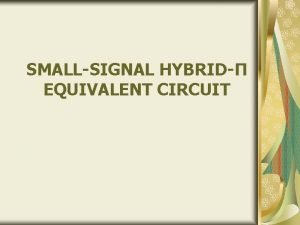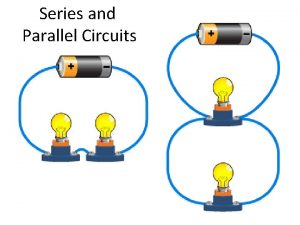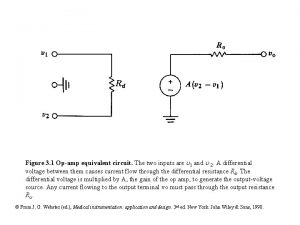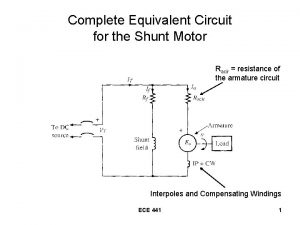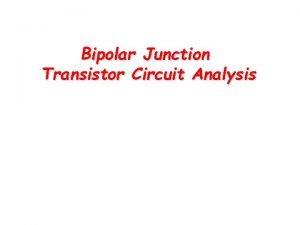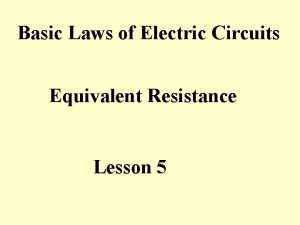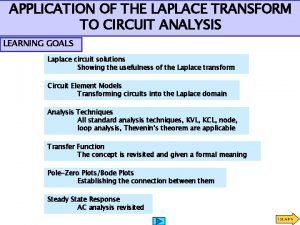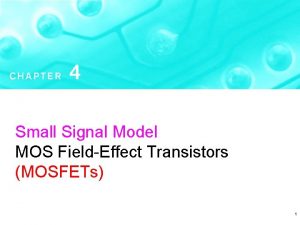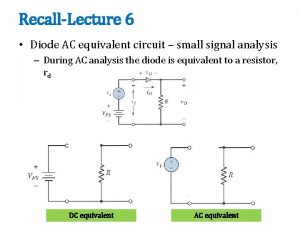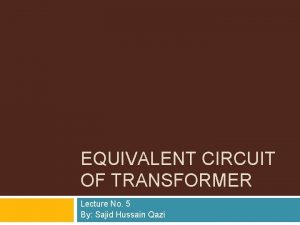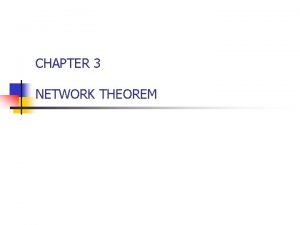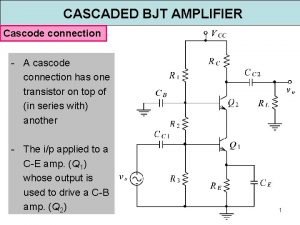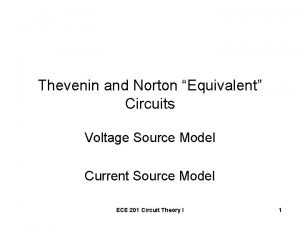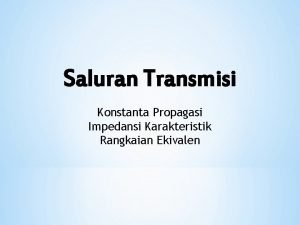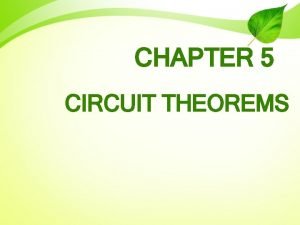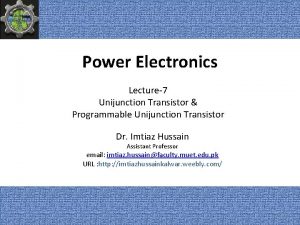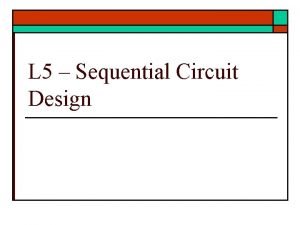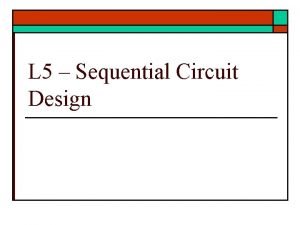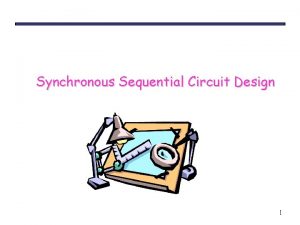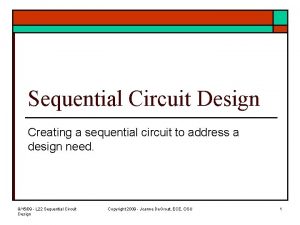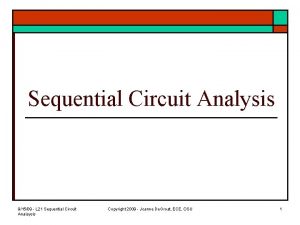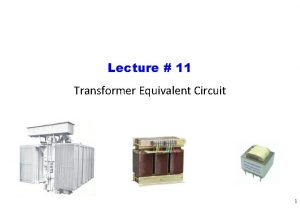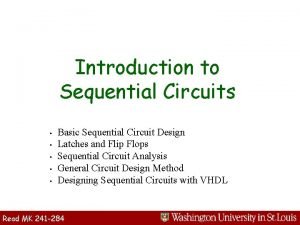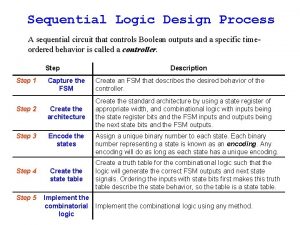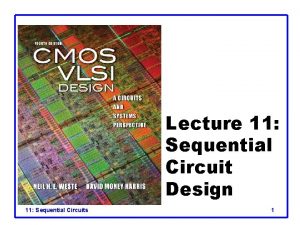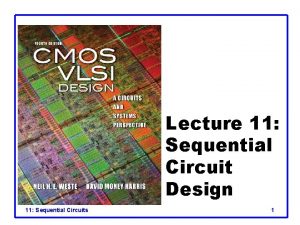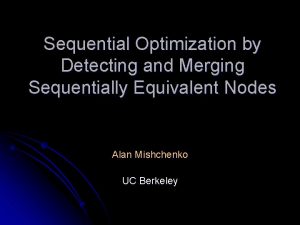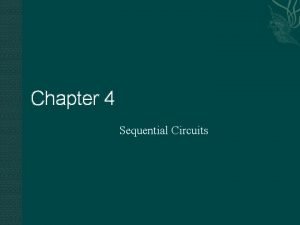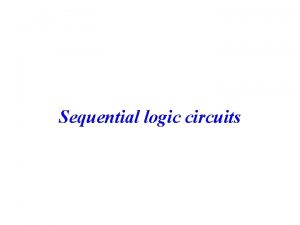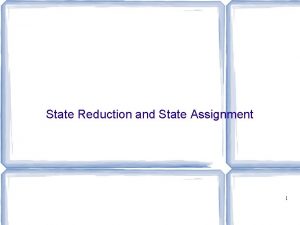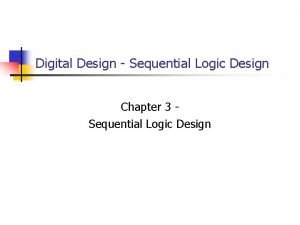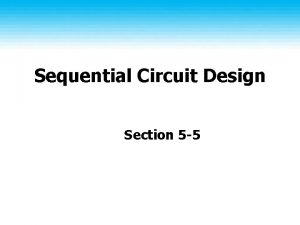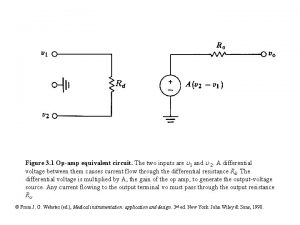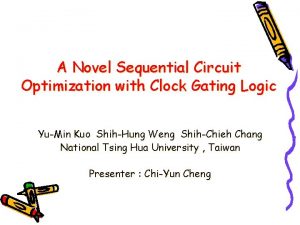Sequential Circuit Design State Optimization Equivalent States Two




























- Slides: 28

Sequential Circuit Design

State Optimization • Equivalent States: Ø Two states are equivalent if, for each member of the set of inputs, Ø they give exactly the same output and Ø send the circuit either to the same state or to an equivalent state. Ø If two states are equivalent, one can be eliminated without effecting the behavior of the FSM. 2

Row Matching Example State Transition Table NS PS x=0 x=1 a a b b c d c a d d e f e a f f g a f output x=0 x=1 0 0 0 0 1 0 1 4

Row Matching Example (cont) NS PS x=0 x=1 a a b b c d c a d d e f e a f f e f output x=0 x=1 0 0 0 0 1 0 1 NS PS x=0 x=1 a a b b c d c a d d e a d output x=0 x=1 0 0 0 0 1 Reduced State Transition Diagram 5

State Optimization Algorithm Implication Chart Prese nt State a Next State Present Output X=0 1 X=0 d c 0 b f h 0 c e d 1 d a e 0 e c a 1 f f b 1 g b h 0 h c g 1 6

State Optimization Algorithm • Implication Chart After First Pass Ø Processing order is important 7

State Optimization Algorithm • Implication Chart After Second Pass Present State Next State Output X=0 1 a a c 0 b f h 0 c c a 1 f f b 1 g b h 0 h c g 1 8

Equivalent Sequential Circuits • Definition: Ø Sequential circuit N 1 is equivalent to sequential circuit N 2 if Ø for each state p in N 1, there is a state q in N 2 such that p≡q , and Ø conversely, for each state s in N 2 , there is a state t in N 1 such that s≡t. 9

Example X=0 X=1 S 0 S 3 S 1 0 1 1 S 3 S 0 0 1 S 2 S 0 S 2 0 0 S 3 S 2 S 3 0 1 X=0 X=1 A B A 0 0 B C D 0 C A C D C B 10

X=0 X=1 S 0 S 3 S 1 0 1 1 S 3 S 0 0 1 S 2 S 0 S 2 0 0 S 3 S 2 S 3 0 1 X=0 X=1 A B A 0 0 B C D 0 C A C D C B • Implication Tables: 11

State Encoding Ø The simplest assignment of s coded states to 2 n possible states is to use the first s binary integers in binary counting order. Ø Ø However, the simplest state assignment does not always lead to the simplest circuit. Ø Ø 000, 001, 010, 011, 100 In fact, the state assignment often has a major effect on circuit cost (was previously shown). In general, the only formal way to find the best assignment is to try all the assignments. Ø That’s too much work!! 12

Moore Machine OKA 0: still OK (because from an OK state, got B=1), and got a 0 on A A 0: got 0 on A Reset/0 A 1: got 1 on A OK 00: got 00 on A OK 11: got 11 on A init 10 11 OKA 1: still OK (because from an OK state, got B=1), and got a 1 on A 00 01 00/01 10 11 A 0 A 1 10 10 11 00 00 01 10 OK 11 OK 00 01 11 00 01 10 11 11 OKA 0 01 15

State Table Ø Ø OK 00 and OKA 0 are equivalent OK 11 and OKA 1 are equivalent 16

Moore Machine OKA 0: still OK (because from an OK state, got B=1), and got a 0 on A A 0: got 0 on A Reset/0 A 1: got 1 on A OK 00: got 00 on A OK 11: got 11 on A init 10 11 OKA 1: still OK (because from an OK state, got B=1), and got a 1 on A 00 01 00/01 10 11 A 0 A 1 10 11 00 OK 1 00 01 10 11 11 OK 0 01 17

State Encoding • Guidelines: Ø Choose an initial coded state into which the machine can easily be forced at reset Ø 00. . . 00 or 11. . . 11 in typical circuits. Ø Minimize the number of state variables that change on each transition. Ø Maximize the number of state variables that don’t change in a group of related states Ø i. e. , a group of states in which most of transitions stay in the group. 18

State Encoding • Samples: 19

Synthesis Using D FF Present State Next State Output 20

State Assignment • Unused States: Ø Each of the m states must be assigned a unique code Ø Minimum number of bits required is n such that n ≥ log 2 m where x is the smallest integer ≥ x Ø There are 2 n - m unused states 21

State Assignment • Unused States: Ø Minimal risk: Ø Assumes that it is possible for the state machine somehow to get into one of the unused (or “illegal”) states, Ø Ø Ø (due to a hardware failure, an unexpected input). Therefore, all of the unused state-variable combinations are identified, and explicit next-state entries are made so that, for any input combination, the unused states go to the “initial” state Minimal cost: Ø Ø Assumes that the machine will never enter an unused state. Therefore, in the transition and excitation tables, the next-state entries of the unused states can be marked as “don’t-cares”. 22

Case 1: Minimal Risk • Assumption: Ø Unused states go to 000 (minimal risk) D 1 = Q 1 + Q 2¢. Q 3¢ 23

Case 1: D 2 Equation D 2 = Q 1. Q 3¢. A¢ + Q 1. Q 3. A + Q 1. Q 2. B 24

Case 1: D 3 Equation D 3 = Q 1. A + Q 2¢. Q 3¢. A 25

Case 1: Z Equation Z = Q 1. Q 2. Q 3¢ + Q 1. Q 2. Q 3 = Q 1. Q 2 26

Case 2: Minimal Cost • Assumption: Ø next states of unused states are “don’t-cares” (minimal cost). Ø Z = don’t care for unused states. D 1 = 1 27

Case 2: D 2 Equation D 2 = Q 1. Q 3¢. A¢ + Q 3. A + Q 2. B 28

Case 2: D 3 Equation D 3 = A 29

Case 2: Z Equation Z = Q 2 30

Case 2: Logic Diagram 31
 Equivalent state
Equivalent state Sequential circuit design
Sequential circuit design Sequential circuit design
Sequential circuit design Sequential model based optimization
Sequential model based optimization Sequential minimal optimization algorithm
Sequential minimal optimization algorithm Sequential circuit analysis
Sequential circuit analysis Rangkaian sekuensial disebut juga
Rangkaian sekuensial disebut juga 74hc161 counter circuit
74hc161 counter circuit Analysis of sequential circuit
Analysis of sequential circuit Sequential circuit analysis
Sequential circuit analysis Concurrent vs sequential
Concurrent vs sequential Moore sequential circuit
Moore sequential circuit Gross torque formula
Gross torque formula Equivalent circuit of bjt
Equivalent circuit of bjt Equivalent resistance of a parallel circuit
Equivalent resistance of a parallel circuit Op amp equivalent circuit
Op amp equivalent circuit Equivalent circuit of shunt dc motor
Equivalent circuit of shunt dc motor Dc analysis of bjt
Dc analysis of bjt Equivalent resistance of a parallel circuit
Equivalent resistance of a parallel circuit S domain capacitor
S domain capacitor Small signal model mosfet
Small signal model mosfet Zener diode small signal model
Zener diode small signal model Practical transformer equivalent circuit
Practical transformer equivalent circuit Norton's equivalent
Norton's equivalent Bjt cascode
Bjt cascode Thevenin model
Thevenin model Konstanta propagasi
Konstanta propagasi Source absorption theorem
Source absorption theorem Ujt intrinsic standoff ratio
Ujt intrinsic standoff ratio
